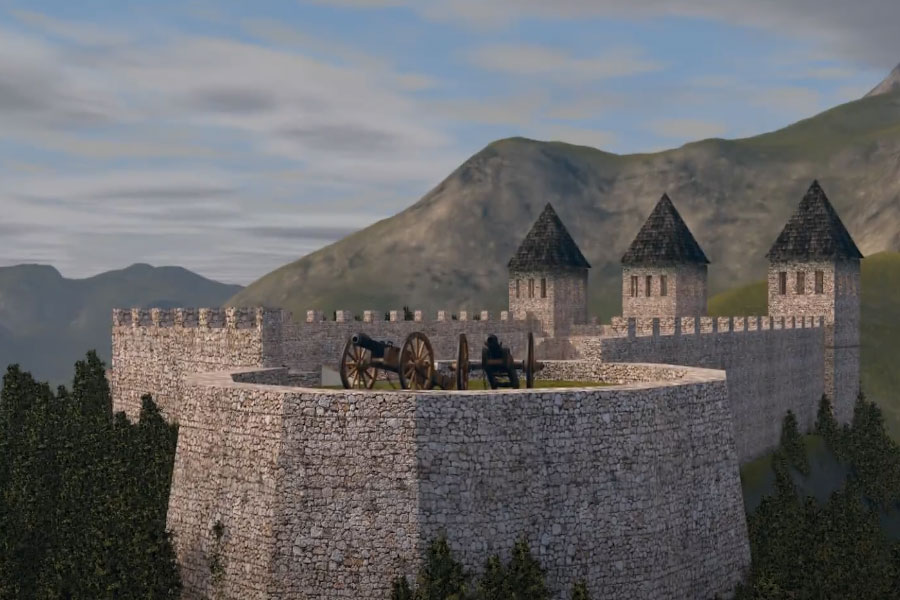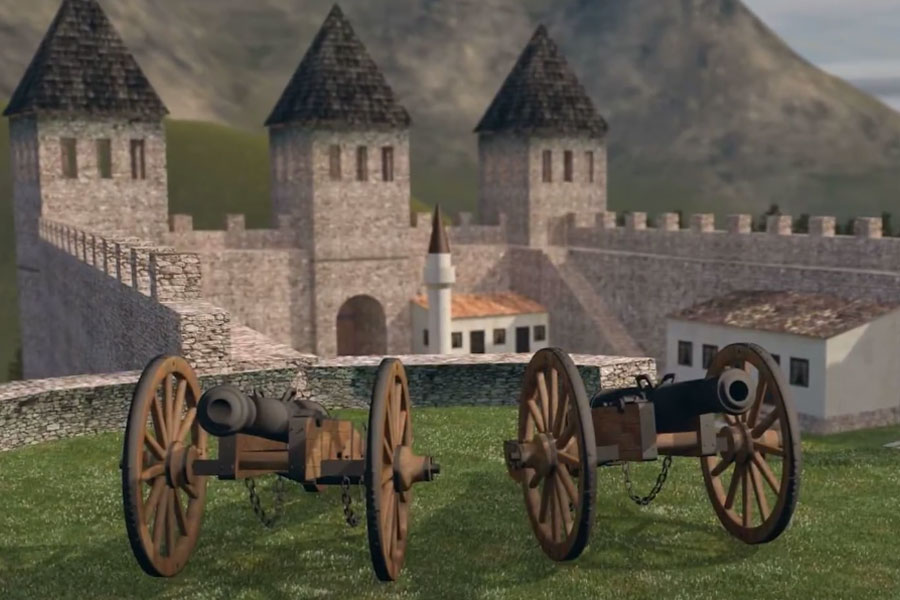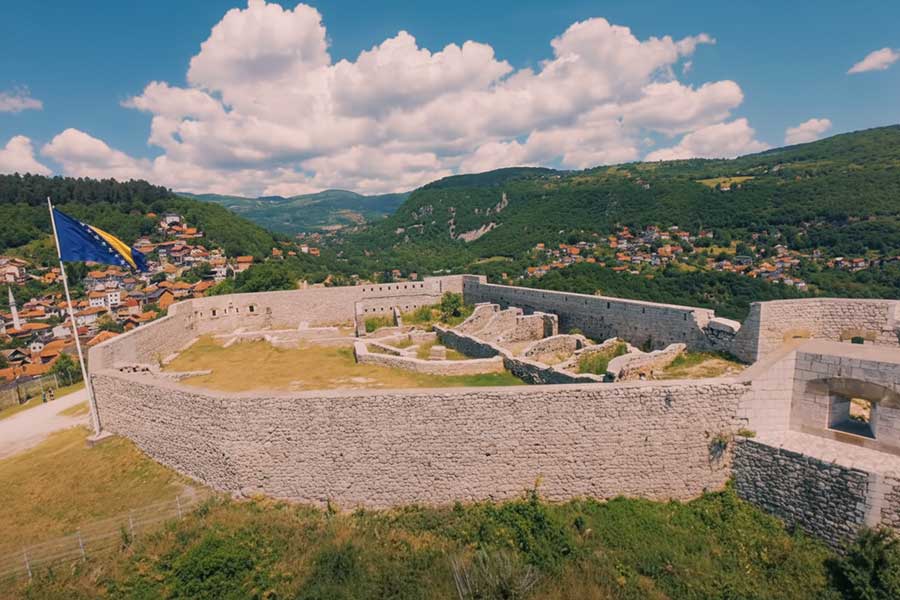On the slopes above Sarajevo, where the old district of Vratnik climbs toward the sky, rises the White Fortress – a stronghold that has been watching over the city for centuries. From its walls stretches a breathtaking view: minarets and church towers in the valley, narrow alleys climbing the hillsides, the Miljacka River winding like a silver thread, and behind it all the mountains forming a natural amphitheater of stone and greenery.
Up here, at almost 700 meters above sea level, one can feel how the city is both fragile and enduring at the same time. Down below life unfolds in all its noise – cars, trams, the smell of ćevapi and coffee – while above, on the fortress, time seems to stand still. The stones remain silent, but in that silence you can hear the echo of history: soldiers’ footsteps, cannon fire, the call of the muezzin, and today, the laughter of couples waiting for the sunset.
The White Fortress is not just cold stone architecture. It is Sarajevo’s witness – a guardian that has seen empires arrive and collapse, wars and sieges come and go, but also reconciliations and new mornings. Whoever stands on its walls will never see Sarajevo in quite the same way again.
Table of Contents
The History of the White Fortress

The first traces of this stronghold date back to the late Middle Ages, around the 14th or early 15th century. At that time Sarajevo was not yet a city, but a settlement in the making, and the hills around it formed a natural line of defense. On one of these hills, above Vratnik, a fortress was built that would guard the city for centuries.
With the arrival of the Ottomans, the White Fortress gained its recognizable look. In the 17th century, the famous traveler Evliya Çelebi described it as a complex with a mosque, granaries, soldiers’ quarters, and even military musicians. Later, during Austro-Hungarian rule, the fortress was reinforced and adapted to modern military needs.
In the 20th century, especially during the Siege of Sarajevo from 1992 to 1995, the fortress once again felt the weight of war. Damaged by shelling and partly ruined, it nevertheless survived. Today it is a protected national monument and one of the most iconic places in Sarajevo.
Who Built the White Fortress?
There is no single builder or ruler to be credited. The oldest parts were created during medieval Bosnia, while the Ottomans shaped it into its current form. Ahmed Pasha Rustempasic Skopljak is mentioned in 1646 as the governor who rebuilt the fortifications of Vratnik, which also reinforced the White Fortress.
In truth, the fortress is the work of centuries – a mosaic of layers, repairs, and additions by countless hands.
The Purpose of the White Fortress

Originally, its purpose was crystal clear – defense. From here the city could be monitored in all directions, especially the eastern approach. The White Fortress stored ammunition and grain, housed soldiers and their families, and contained a mosque and living quarters.
Today its purpose has changed. The fortress is no longer a bastion of war, but a viewpoint and tourist attraction – a place where history and panorama meet in one unforgettable experience.
Key Historical Moments of Sarajevo’s White Fortress
- 18th–19th century: Strategic defense point during Ottoman uprisings and Austro-Hungarian conflicts.
- 1878: Played a role during the Austro-Hungarian occupation of Sarajevo.
- 1992–1995: Damaged by shelling during the Siege of Sarajevo.
- 2005: Declared a National Monument of Bosnia and Herzegovina.
Why is the White Fortress Famous Today?
Source: Youtube channel Edin Rahic
Today the White Fortress is famous as the best viewpoint in Sarajevo. The panorama is especially magical at sunset, when the city lights turn on and the valley glows beneath a purple-orange sky.
It is also part of the fortification system of Vratnik, together with the Yellow Fortress (Žuta tabija) and the Visegrad Gate. For both tourists and locals, it is a must-see spot, as iconic as Baščaršija or the City Hall.
Sarajevo White Fortress: Location & How to Get There
The White Fortress is located on the southeastern slopes of Vratnik, at 667 meters above sea level.
You can reach it in several ways:
- On foot: about 20 minutes from Baščaršija through the cobblestone streets of Vratnik.
- By taxi or car: direct access is possible, though parking is limited.
- By public transport: take the bus to Visegrad Gate and then walk 10 minutes uphill.
⏰ Opening hours: daily, 10:00 – 19:00
🎟️ Entrance fee: approx. 5 BAM (about €2.50)
What’s There Today?

Nearly three decades later, Sarajevo is a modern, vibrant city – a tourist destination and cultural hub. Yet, reminders of the siege remain: Sarajevo Roses filled with red resin, the Tunnel Museum, memorials, and the stories of survivors.
Every street has its story. Every scar tells of both tragedy and resilience. Sarajevo today is a paradox – a city of sorrow and a city of hope, all at once.
Tips for Visiting Sarajevo’s White Fortress
- Best time to visit: sunset or early morning for the light and atmosphere.
- Wear comfortable shoes and bring water, especially if walking uphill.
- Combine the visit with the Yellow Fortress for a fuller experience of Sarajevo’s old defenses.
- For a quieter experience, go on a weekday or early in the morning.
Fun Facts About White Fortress
- The name “White Fortress” likely comes from the pale stone, but legend says the walls were once “whitened” with a mixture of milk and egg whites.
- Old Austro-Hungarian maps from the 19th century show the remains of an octagonal mosque within the fortress walls.
- For centuries, the White Fortress was not just a military site but a small community, housing soldiers, their families, imams, and musicians.
FAQ – White Fortress Sarajevo
What is the White Fortress in Sarajevo?
The White Fortress (Bijela tabija) is a medieval fortress above Sarajevo, part of the old Vratnik fortification system.
How do I get to the White Fortress?
The easiest way is on foot from Baščaršija (20 minutes uphill) or by taxi. Buses go to Visegrad Gate, from where it’s a short walk.
How much is the entrance fee?
Around 5 BAM per person (approx. €2.50).
When is the best time to visit?
At sunset or early morning, when the city looks its most magical.
Is the White Fortress open year-round?
Yes, it is open daily, usually from 10:00 to 19:00.
Our Most Popular Tours To Sarajevo
We offer many tours that include a visit to Sarajevo and its most popular locations:
- Sarajevo Siege Tour & War Tunnel 1992 / 1996 (Most Popular)
- Full Day tour from Sarajevo to Međugorije & Mostar
- Full Day Tour from Sarajevo to Travnik and Jajce
- Full-Day 5 Cities Tour from Sarajevo to Herzegovina (Mostar)
- Full day Tour from Sarajevo to Dubrovnik (Kotor or Split)
- Full Day tour from Sarajevo to Belgrade
Don’t Hesitate To Say Hi!
Got any questions about our tours or the city? Don’t hesitate to contact us anytime for more info and booking.
Use the following phone number and email:

